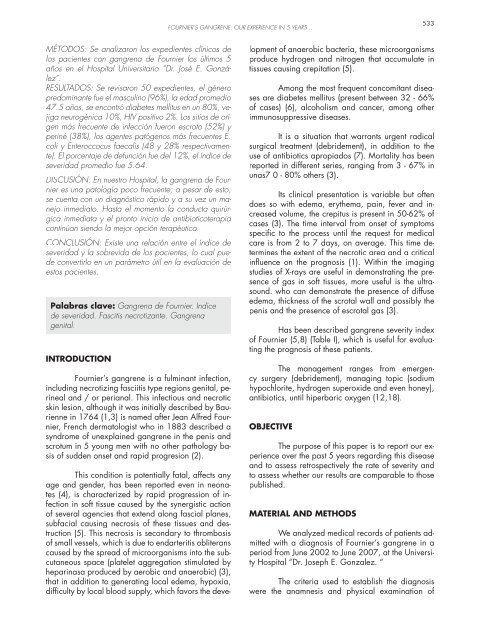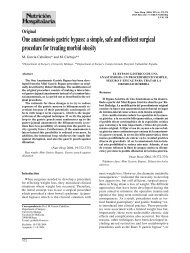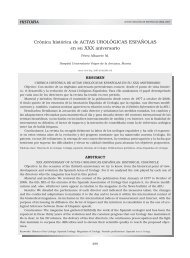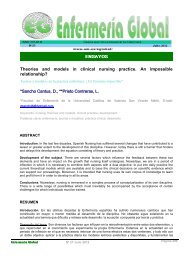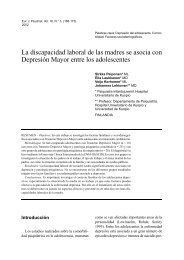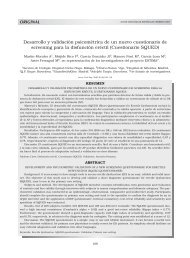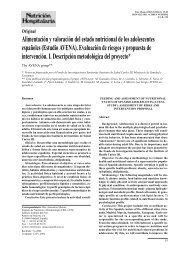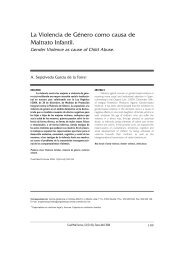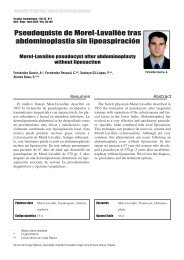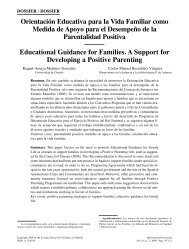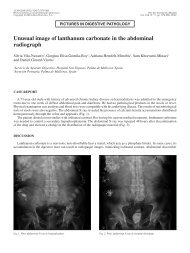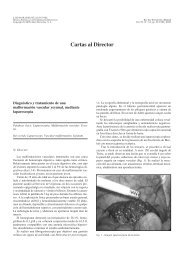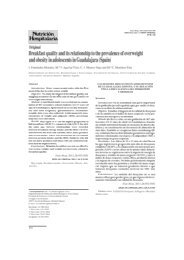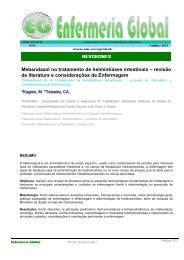fournier's gangrene: our experience in 5 years, bibliographic
fournier's gangrene: our experience in 5 years, bibliographic
fournier's gangrene: our experience in 5 years, bibliographic
You also want an ePaper? Increase the reach of your titles
YUMPU automatically turns print PDFs into web optimized ePapers that Google loves.
MÉTODOS: Se analizaron los expedientes clínicos de<br />
los pacientes con gangrena de F<strong>our</strong>nier los últimos 5<br />
años en el Hospital Universitario “Dr. José E. González”.<br />
RESULTADOS: Se revisaron 50 expedientes, el género<br />
predom<strong>in</strong>ante fue el mascul<strong>in</strong>o (96%), la edad promedio<br />
47.5 años, se encontró diabetes mellitus en un 80%, vejiga<br />
neurogénica 10%, HIV positivo 2%. Los sitios de origen<br />
más frecuente de <strong>in</strong>fección fueron escroto (52%) y<br />
per<strong>in</strong>é (38%), los agentes patógenos más frecuentes E.<br />
coli y Enteroccocus faecalis (48 y 28% respectivamente).<br />
El porcentaje de defunción fue del 12%, el índice de<br />
severidad promedio fue 5.64.<br />
DISCUSIÓN: En nuestro Hospital, la gangrena de F<strong>our</strong>nier<br />
es una patología poco frecuente; a pesar de esto,<br />
se cuenta con un diagnóstico rápido y a su vez un manejo<br />
<strong>in</strong>mediato. Hasta el momento la conducta quirúrgica<br />
<strong>in</strong>mediata y el pronto <strong>in</strong>icio de antibioticoterapia<br />
cont<strong>in</strong>úan siendo la mejor opción terapéutica.<br />
CONCLUSIÓN: Existe una relación entre el índice de<br />
severidad y la sobrevida de los pacientes, lo cual puede<br />
convertirlo en un parámetro útil en la evaluación de<br />
estos pacientes.<br />
Palabras clave: Gangrena de F<strong>our</strong>nier. Indice<br />
de severidad. Fascitis necrotizante. Gangrena<br />
genital.<br />
INTRODUCTION<br />
F<strong>our</strong>nier’s <strong>gangrene</strong> is a fulm<strong>in</strong>ant <strong>in</strong>fection,<br />
<strong>in</strong>clud<strong>in</strong>g necrotiz<strong>in</strong>g fasciitis type regions genital, per<strong>in</strong>eal<br />
and / or perianal. This <strong>in</strong>fectious and necrotic<br />
sk<strong>in</strong> lesion, although it was <strong>in</strong>itially described by Baurienne<br />
<strong>in</strong> 1764 (1,3) is named after Jean Alfred F<strong>our</strong>nier,<br />
French dermatologist who <strong>in</strong> 1883 described a<br />
syndrome of unexpla<strong>in</strong>ed <strong>gangrene</strong> <strong>in</strong> the penis and<br />
scrotum <strong>in</strong> 5 young men with no other pathology basis<br />
of sudden onset and rapid progresion (2).<br />
This condition is potentially fatal, affects any<br />
age and gender, has been reported even <strong>in</strong> neonates<br />
(4), is characterized by rapid progression of <strong>in</strong>fection<br />
<strong>in</strong> soft tissue caused by the synergistic action<br />
of several agencies that extend along fascial planes,<br />
subfacial caus<strong>in</strong>g necrosis of these tissues and destruction<br />
(5). This necrosis is secondary to thrombosis<br />
of small vessels, which is due to endarteritis obliterans<br />
caused by the spread of microorganisms <strong>in</strong>to the subcutaneous<br />
space (platelet aggregation stimulated by<br />
hepar<strong>in</strong>asa produced by aerobic and anaerobic) (3),<br />
that <strong>in</strong> addition to generat<strong>in</strong>g local edema, hypoxia,<br />
diffi culty by local blood supply, which favors the deve-<br />
FOURNIER’S GANGRENE: OUR EXPERIENCE IN 5 YEARS...<br />
533<br />
lopment of anaerobic bacteria, these microorganisms<br />
produce hydrogen and nitrogen that accumulate <strong>in</strong><br />
tissues caus<strong>in</strong>g crepitation (5).<br />
Among the most frequent concomitant diseases<br />
are diabetes mellitus (present between 32 - 66%<br />
of cases) (6), alcoholism and cancer, among other<br />
immunosuppressive diseases.<br />
It is a situation that warrants urgent radical<br />
surgical treatment (debridement), <strong>in</strong> addition to the<br />
use of antibiotics apropiados (7). Mortality has been<br />
reported <strong>in</strong> different series, rang<strong>in</strong>g from 3 - 67% <strong>in</strong><br />
unas7 0 - 80% others (3).<br />
Its cl<strong>in</strong>ical presentation is variable but often<br />
does so with edema, erythema, pa<strong>in</strong>, fever and <strong>in</strong>creased<br />
volume, the crepitus is present <strong>in</strong> 50-62% of<br />
cases (3). The time <strong>in</strong>terval from onset of symptoms<br />
specifi c to the process until the request for medical<br />
care is from 2 to 7 days, on average. This time determ<strong>in</strong>es<br />
the extent of the necrotic area and a critical<br />
<strong>in</strong>fl uence on the prognosis (1). With<strong>in</strong> the imag<strong>in</strong>g<br />
studies of X-rays are useful <strong>in</strong> demonstrat<strong>in</strong>g the presence<br />
of gas <strong>in</strong> soft tissues, more useful is the ultrasound.<br />
who can demonstrate the presence of diffuse<br />
edema, thickness of the scrotal wall and possibly the<br />
penis and the presence of escrotal gas (3).<br />
Has been described <strong>gangrene</strong> severity <strong>in</strong>dex<br />
of F<strong>our</strong>nier (5,8) (Table I), which is useful for evaluat<strong>in</strong>g<br />
the prognosis of these patients.<br />
The management ranges from emergency<br />
surgery (debridement), manag<strong>in</strong>g topic (sodium<br />
hypochlorite, hydrogen superoxide and even honey),<br />
antibiotics, until hiperbaric oxygen (12,18).<br />
OBJECTIVE<br />
The purpose of this paper is to report <strong>our</strong> <strong>experience</strong><br />
over the past 5 <strong>years</strong> regard<strong>in</strong>g this disease<br />
and to assess retrospectively the rate of severity and<br />
to assess whether <strong>our</strong> results are comparable to those<br />
published.<br />
MATERIAL AND METHODS<br />
We analyzed medical records of patients admitted<br />
with a diagnosis of F<strong>our</strong>nier’s <strong>gangrene</strong> <strong>in</strong> a<br />
period from June 2002 to June 2007, at the University<br />
Hospital “Dr. Joseph E. Gonzalez. “<br />
The criteria used to establish the diagnosis<br />
were the anamnesis and physical exam<strong>in</strong>ation of


